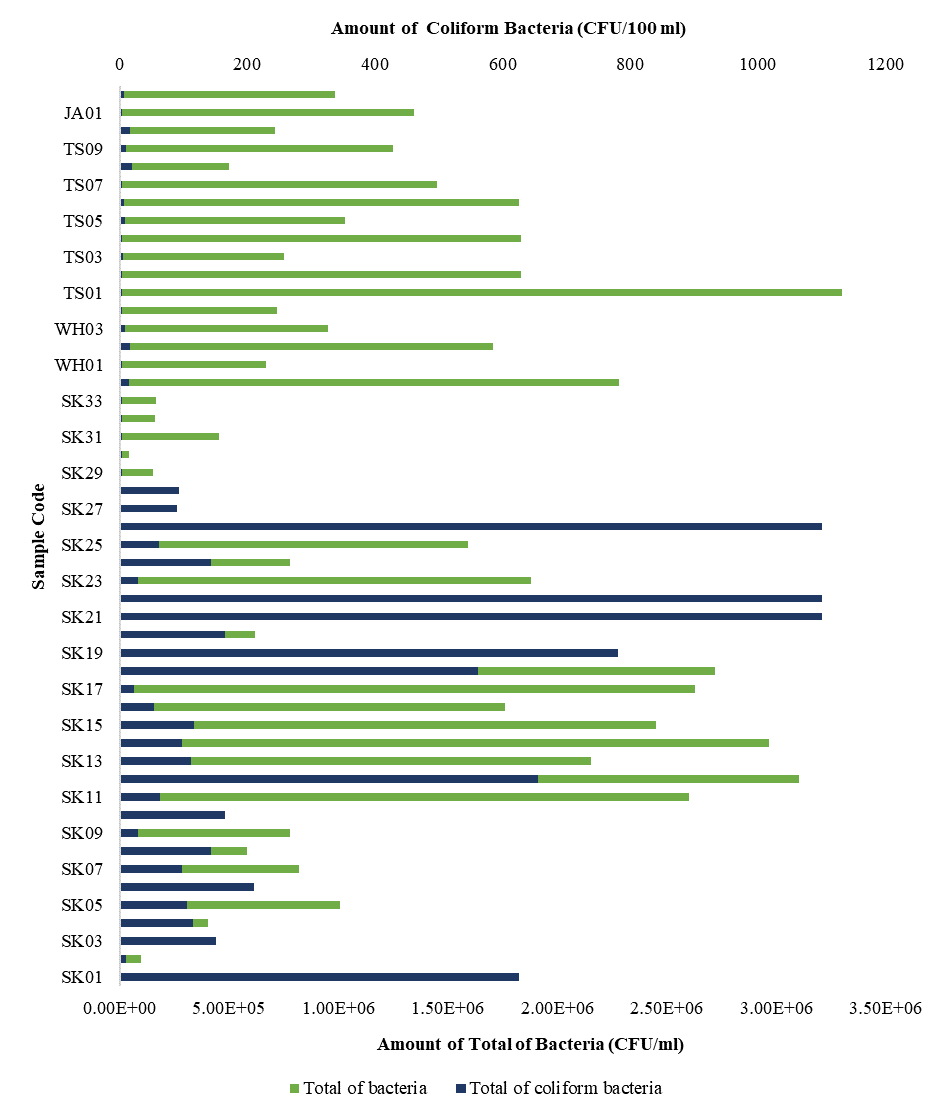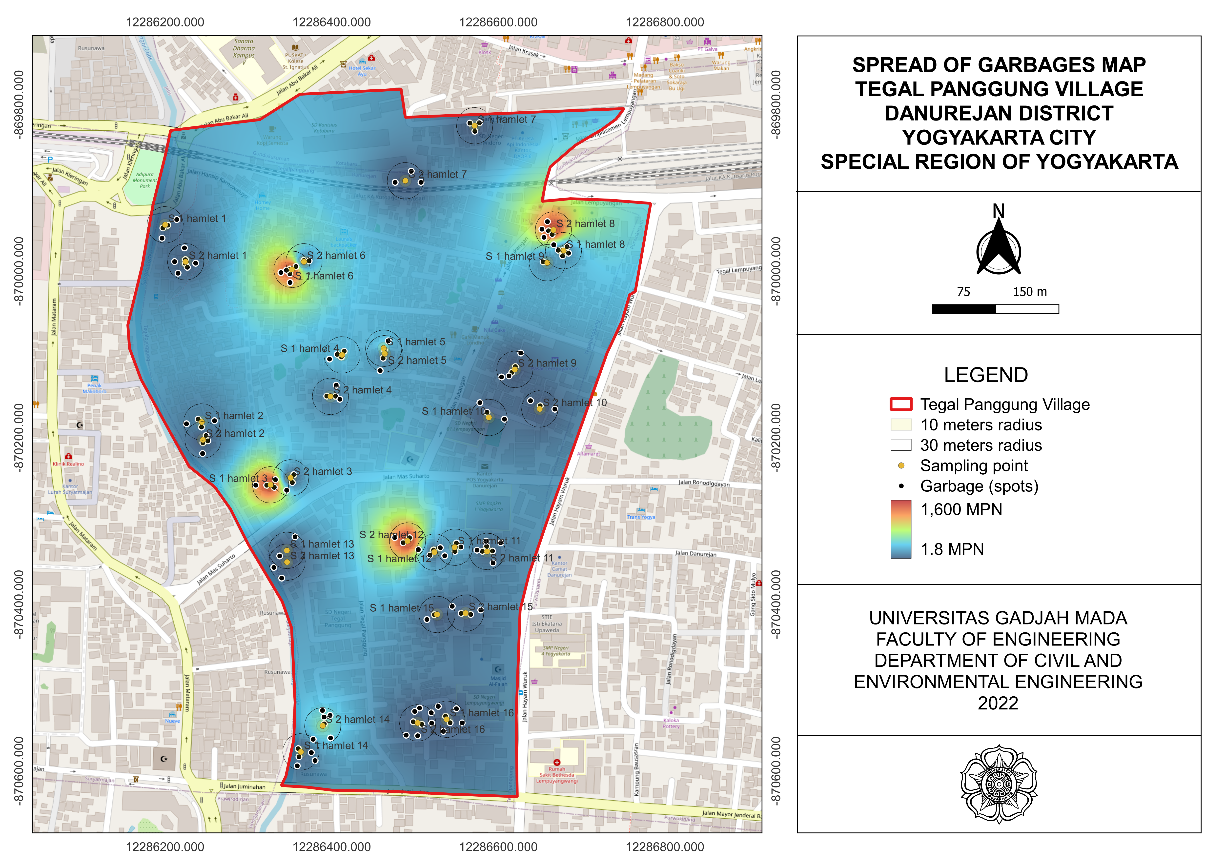Analysis Flies Density at Final Waste Disposal Jember Distric Area, Indonesia (Studi at Pakusari landfill and Ambulu landfill)
Downloads
Introduction: Flies can transmitted disease. The final waste disposals were the breeding place of flies, especially when the final waste disposals weren`t implementation in good management. The objectives of the research were to analyze the differences between flies density in the Pakusari landfill and Ambulu landfill, Jember District, Indonesia. Method: the method was analytic with a cross-sectional design. The data were collected with observation, interview and measure the flies density. The population was all of the area kavling in the Pakusari and Ambulu landfill. The samples were total population. There were 4 active kavling in the landfill, and interview 68 head of the family which stays around the landfill how the flies disrupt their daily activity. The measurements of flies density were using fly grill, stopwatch, form the flies density. The type of flies was identification. Result and Discussion: Waste disposal management at Pakusari landfill was a controlled landfill, and Ambulu was open dumping. Both of flies density of the landfill were categorized very high. The measurement of flies density was in September 2019, whereas the Pakusari landfill using open dumping because of the equipment was broken. The highest flies density on Pakusari at kavling 2 dan 3,4 were 44,4 per 30 seconds (point 1) and 42,4 per 30 seconds (point 1). At kavling 2, 3 Ambulu landfills were 34 per 30 seconds (point 6) and 31,4 per second (point 1) There were sig difference flies density between Pakusari and Ambulu landfill (p=0,000). The most of flies were Musca Domestica(81%). The most distribution of flies were disturbed by the view, causing diarrhea, typus. Conclussion: Waste disposal landfill management should be improving with sanitary landill to control the flies density and decrease the vector-borne disease.
Prajati G, Tri PB. Pengaruh Faktor faktor Ekonomi dan Kependudukan Terhadap Timbulan Sampah di Ibu Kota Provinsi Jawa dan Sumatra. J Teknik Lingkungan. 2015;21(1):39–47. Doi: http://dx.doi.org/10.5614%2Fjtl.2015.21.1.5
Badan Pusat Statistik. Statistik Lingkungan Hidup Indonesian, Pegelolaan Sampah di Indonesia. 2017. http://www.bps.go.id
Riyadi. Ilmu Kesehatan Masyarakat. Yogyakarta: Andi offset; 2016.
Badan Pusat Statistik. Badan Pusat Statistik Lingkungan Hidup. Badan Pusat Statistik. 2018. http://www.bps.go.id
Kementrian Lingkungan Hidup dan Kehutanan. Kementrian Lingkungan Hidup dan Kehutanan. 2019. https://dataalam.menlhk.go.id/sampah/terbaru
Direktorat Pengelolaan Sampah Kementrian Lingkungan Hidup dan Kehutanan. Sistem Informasi Pengelolaan Sampah Nasional, Komposisi Sampah. Pengantar Penyusunan Naskah Akademik Rapermen LHK. 2019. p. 35 halaman. http://ditjenppi.menlhk.go.id/reddplus/images/resources/ws_transperancy_framework/r4_02_sampah_klhk.pdf
Zulkifli A. Dasar Dasar Ilmu Lingkungan. Jakarta: Salemba Teknika; 2014.
Moelyaningrum AD; Pujiati RS. Cadmium ( Cd ) and Mercury ( Hg ) in the Soil, Leachate and Ground Water at the Final Waste Disposal Pakusari Jember Distric Area. Intenational J Sci Basic Appl Res. 2015;4531(3):101–108. https://gssrr.org/index.php/JournalOfBasicAndApplied/article/view/4541
Qadriyah L, Moelyaningrum AD, Ningrum PT. Kadar Kadmium Pada Air Sumur Gali Disekitar Tempat Pemrosesan Akhir Sampah (Studi di Tempat Pemrosesan Akhir Sampah X Kabupaten Jember, Indonesia). BIOLINK. 2019;6(1):41-49. Doi: http://dx.doi.org/10.31289/biolink.v6i1.2400
Moelyaningrum AD. Correlation Between Blood Lead Level (BLL) And Osteoporosis in Postmenopausal Women In Surabaya Indonesia Anita Dewi Moelyaningrum. The 1st International Symposium of Public Health “ Emerging and Re emerging Disease. Surabaya; 2017:190–197. https://doi.org/10.31227/osf.io/8uqza
Moelyaningrum AD. Timah Hitam (Pb) dan Karies Gigi. J Stomatognatic. 2016;13(1):28–31. https://jurnal.unej.ac.id/index.php/STOMA/article/view/4479
Prayogo S, Khomsatun K. Deskripsi Kepadatan Lalat Di Pasar Kota Banjarnegara Tahun 2015. Bul Keslingmas. 2015;34(3):220–223. https://doi.org/10.31983/keslingmas.v34i3.3078
Nazari M, Mehrabi T, Hosseini SM, Alikhani MY. Bacterial Contamination of Adult House Flies ( Musca domestica ) and Sensitivity of these Bacteria to Various Antibiotics , Captured from Hamadan City , Iran. J Clin Diagnostic Res. 2017;11(4):4–7. http://www.jcdr.net
Departemen Kesehatan Republik Indonesia. Petunjuk Teknis Pemberantasan Lalat. Jakarta: Dirjen PPM dan PL; 1992.
Badan Standarisasi Nasional. Standar Nasional Indonesia (SNI) 1932411994 tentang Tata Cara Pemilihan Lokasi Tempat Pembuangan Sampah. Jakarta: Departemen Pekerjaan Umum; 1994.
Husin H. Identifikasi Kepadatan Lalat di Perumahan yang Berada di Tempat Pembuangan Akhir (TPA) Sampah Air Sebakul Kecamatan Selebar Kota Bengkulu. J Nurs Public Health. 2017;5(1):80–87. https://doi.org/10.37676/jnph.v5i1.603
Hidayat A, Desimal I. Jarak Tempat Pembuangan Sampah Sementara (TPS) Mempengaruhi Kepadatan Lalat pada Tempat Penjualan Makanan dan Minuman. J Sangkareang Mataram. 2015;1(1):39–42. http://untb.ac.id/wp-content/uploads/2016/01/6-jarak-tempat-pembuangan-sampah-sementara-tps-Iwan-desimal.pdf
Sarah S, Nurmaini SD. Hubungan Kepadatan Lalat, Personal Hygiene dan Sanitasi Dasar dengan Kejadian Diare pada Balita di Lingkungan Kelurahan Medan Marelan Kota Medan. J Lingkungan dan Keselamatan Kerja. 2015;4(3):1–10. https://jurnal.usu.ac.id/index.php/lkk/article/view/10814
Terry, Pristya, Fajaria N, Azizah M. Kepadatan Lalat dan Hubungan dengan Diare Disekitar Tempat Pemprosesan Akhir Sampah Kota Depok. Kesmas. 2019;11(1):9–23. https://doi.org/10.20884/1.ki.2019.11.1.1321
Pengelolaan Sampah Rumah Tangga dan Sampah Sejenis Sampah Rumah Tangga. Peraturan Pemerintah Republik Indonesia No. 81 tahun 20112. 2012.
Sukmawati NL, Ginanjar P, Hestinigsih R. Keanekaragaman Spesies Lalat dan Jenis Bakteri Kontaminan yang Dibawa Lalat di Rumah Pemotongan Unggas (RPU) Semarang Tahun 2018. J Kesehat Masy. 2019;7(1):252–259. https://ejournal3.undip.ac.id/index.php/jkm/article/view/22878
Masyhuda. Survei Kepadatan Lalat di Tempat Pembuangan Akhir Sampah Jatibarang. J Kesehtan Masyarakt. 2017;5(4):562–567. https://ejournal3.undip.ac.id/index.php/jkm/article/view/18714
Dinas Lingkungan Hidup Kabupaten Jember. Sampah Kabupaten Jember. Jember: Dinas Lingkungan Hidup Kabupaten Jember; 2017.
Departemen Pengembangan Sanitasi Air. Proses Pengelolaan Sampah Organik dengan Back Soldier Fly (BSF). Jakarta: Departemen Pengembangan Sanitasi Air; 2017.
Khamesipour F, Kamran BT. A systemic Review of Human Pathogens Carried by the Housefly (Musca Domestika). BMC Public Health. 2018;18(1049):1–15. https://bmcpublichealth.biomedcentral.com/articles/10.1186/s12889-018-5934-3
Salimi M, Rassi Y, Oshaghi M, Chatrabgoun O, Limoee M. Temperature Requirements For The Growth Of Immature Stages Of Blowflies Species , Chrysomya Albiceps and Calliphora Vicina, (Diptera : Calliphoridae) Under Laboratory Conditions. Egypt J Forensic Sci. 2018;8(28):4–9. https://doi.org/10.1186/s41935-018-0060-z
Anisa S, Mardiana H. Analisis Willingness to Pay (WTP) Sampah Rumah Tangga (Studi kasus Perumnas Kelurahan Simpang Baru Panam Pekan Baru). JOM FEKON. 2015;2(1):1–16. https://jom.unri.ac.id/index.php/JOMFEKON/article/view/7922
Onwugamba FC, Fitzgerald JR, Rochon K, Guardabassi L, Alabi A, Kühne S, et al. The Role of ‘ Filth Flies ’ In the Spread of Antimicrobial Resistance. Travel Med Infect Dis. 2018;22(March):8–17. https://doi.org/10.1016/j.tmaid.2018.02.007
Andiarsa D, Setyaningtyas DE, Setianingsih I, Fadilly A, Hidayat S. Efektifitas Penggunaan Manitoba Trap dalam Surveilans Penyakit Bersumber Lalat di Kabupaten Tanah Bumbu, Kalimantan Selatan. Balaba. 2016;12(2):79–88. https://doi.org/10.22435/blb.v12i2.201
Pava-ripoll M, Pearson RE, Miller AK, Ziobro GC. Detection of Foodborne Bacterial Pathogens from Individual Filth Flies. J Vis Exp. 2015;96:1–9. https://www.jove.com/video/52372/detection-of-foodborne-bacterial-pathogens-from-individual-filth-flies
Sanchez H, Capinera JL. House fly , Musca domestica Linnaeus, Insecta : Diptera: Muscidae. Florida: Department of Entomology and Nematology of Uiversity Florida; 2017. http://edis.ifas.ufl.edu/pdffiles/IN/IN20500.pdf
Wang X, Wang J, Sun H, Xia S, Duan R, Liang J. Etiology of Childhood Infectious Diarrhea in a Developed Region of China : Compared to Childhood Diarrhea in a Developing Region and Adult Diarrhea in a Developed Region. J Pone. 2015;3(1):1–14. https://journals.plos.org/plosone/article?id=10.1371/journal.pone.0142136
Prasetya DR, Amalia Y. Pengaruh Variasi Warna Lampu pada Alat Perekat Lalat Terhadap Jumlah Lalat Rumah (Musca Domestica) yang Terperangkap. Balaba. 2015;11(1):29–34. http://ejournal.litbang.kemkes.go.id/index.php/blb/article/view/4152
Nadeak ESM, T Rwanda II. Efektifitas Variasi Umpan Dalam Penggunaan Fly Trap Di Temp8at Pembuangan Akhir Ganet Kota Tanjungpinang. J Kesehat Masy Andalas. 2015;1(1):82–86. http://jurnal.fkm.unand.ac.id/index.php/jkma/article/view/167
2. Formal legal provisions to access digital articles of electronic journal are subject to the provision of the Creative Commons Attribution-ShareAlike license (CC BY-NC-SA), which means that Jurnal Kesehatan Lingkungan is rightful to keep, transfer media/format, manage in the form of databases, maintain, and publish articles.
3. Published manuscripts both printed and electronic are open access for educational, research, and library purposes. Additionally, the editorial board is not responsible for any violations of copyright law.
JKESLING by UNAIR is licensed under a Creative Commons Attribution-ShareAlike 4.0 International License.







































